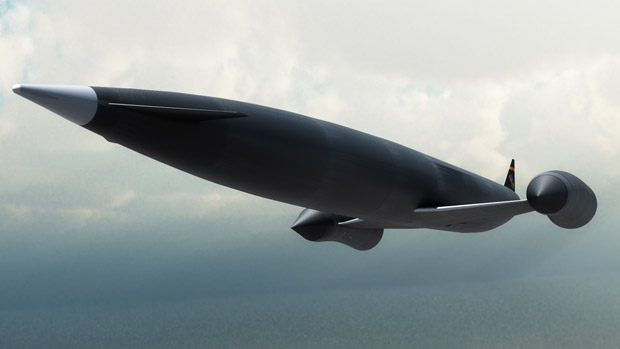Skylon: how the Mach 5 space plane will work
London to Sydney would take just four hours in the Skylon space plane – which could be flying by 2019

The European Space Agency has given its approval to technology developed by a British firm which could transform space travel – and lead to the development of an airliner capable of taking 300 passengers from Europe to Australia in four hours.
The Skylon aircraft is still at the theoretical stage, but the government is funding its development.
What is Skylon?
The Week
Escape your echo chamber. Get the facts behind the news, plus analysis from multiple perspectives.

Sign up for The Week's Free Newsletters
From our morning news briefing to a weekly Good News Newsletter, get the best of The Week delivered directly to your inbox.
From our morning news briefing to a weekly Good News Newsletter, get the best of The Week delivered directly to your inbox.
A British company based in Oxfordshire, Reaction Engines Ltd, has developed a new type of jet engine, known as Sabre (Synergistic Air-Breathing Rocket Engine), which they say could power a space plane.
The proposed aircraft, the Skylon, would use Sabre engines to carry 300 passengers from Europe to Australia within four hours.
The company has not yet built a full version of the engine, but it has constructed a critical component and now hopes to launch it as soon as 2019.
How will it work?
A free daily email with the biggest news stories of the day – and the best features from TheWeek.com
The heat exchanger made by Reaction is the key to the new technology, says The Independent. It cools air from 1,000C to 150C in one hundredth of a second, allowing the engine to use air as fuel, rather than oxygen from a tank.
Reaction's heat exchanger will solve a problem that has prevented most gas-turbine jet engines from being able to go faster than 2.5 times the speed of sound. The Concorde, for example, flew no faster than Mach 2. According to researchers, the new technology may allow planes to travel at more than twice that speed.
What problem does it solve?
Existing space rockets must carry tanks of oxygen with them – and the weight slows everything down. Reaction researchers believe their new technology could make space travel 95 per cent cheaper.
If it works, Sabre technology could allow a jet aircraft to carry satellites and other spacecraft beyond the earth's atmosphere before returning to the planet below. It could also be used to transport passengers quickly between distant locations on earth significantly more quickly than is currently possible.
What happens next?
The latest development is that the ESA have looked at Reaction's data and agreed that the heat exchange technology is viable and workable. The next stage is to build working prototype of the full Sabre engine.
Last year, says the Daily Mail, the government announced it was investing £60m in building just such a prototype.
-
 The ultimate films of 2025 by genre
The ultimate films of 2025 by genreThe Week Recommends From comedies to thrillers, documentaries to animations, 2025 featured some unforgettable film moments
-
 Political cartoons for January 3
Political cartoons for January 3Cartoons Saturday's political cartoons include citizen journalists, self-reflective AI, and Donald Trump's transparency
-
 Into the Woods: a ‘hypnotic’ production
Into the Woods: a ‘hypnotic’ productionThe Week Recommends Jordan Fein’s revival of the much-loved Stephen Sondheim musical is ‘sharp, propulsive and often very funny’
-
 Sport on TV guide: Christmas 2022 and New Year listings
Sport on TV guide: Christmas 2022 and New Year listingsSpeed Read Enjoy a feast of sporting action with football, darts, rugby union, racing, NFL and NBA
-
 House of the Dragon: what to expect from the Game of Thrones prequel
House of the Dragon: what to expect from the Game of Thrones prequelSpeed Read Ten-part series, set 200 years before GoT, will show the incestuous decline of Targaryen
-
 One in 20 young Americans identify as trans or non-binary
One in 20 young Americans identify as trans or non-binarySpeed Read New research suggests that 44% of US adults know someone who is transgender
-
 The Turner Prize 2022: a ‘vintage’ shortlist?
The Turner Prize 2022: a ‘vintage’ shortlist?Speed Read All four artists look towards ‘growth, revival and reinvention’ in their work
-
 What’s on TV this Christmas? The best holiday television
What’s on TV this Christmas? The best holiday televisionSpeed Read From films and documentaries to musicals for all the family
-
 Coco vision: up close to Chanel opticals
Coco vision: up close to Chanel opticalsSpeed Read Parisian luxury house adds opticals to digital offering
-
 Abba returns: how the Swedish supergroup and their ‘Abba-tars’ are taking a chance on a reunion
Abba returns: how the Swedish supergroup and their ‘Abba-tars’ are taking a chance on a reunionSpeed Read From next May, digital avatars of the foursome will be performing concerts in east London
-
 ‘Turning down her smut setting’: how Nigella Lawson is cleaning up her recipes
‘Turning down her smut setting’: how Nigella Lawson is cleaning up her recipesSpeed Read Last week, the TV cook announced she was axing the word ‘slut’ from her recipe for Slut Red Raspberries in Chardonnay Jelly